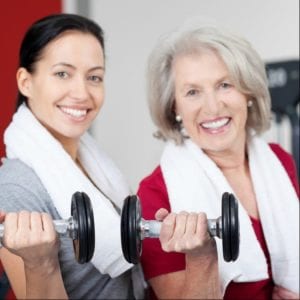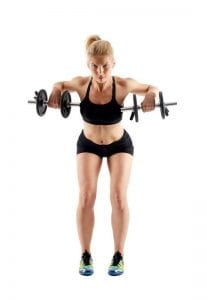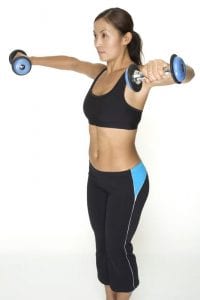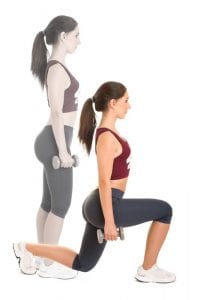 In this article, we will be looking at five of the best bone-strengthening exercises using weights.
In this article, we will be looking at five of the best bone-strengthening exercises using weights.
Regular strength training has many benefits. The most obvious is that it improves strength, tones muscles, lowers body fat, and, over time, promotes weight loss through calories burned.
Another advantage of this type of workout is that it is weight-bearing. Undertaking weight-bearing exercise regularly is proven to build stronger bones, slow bone loss as we age, and prevent brittle bones, which can lead to osteoporosis.
These benefits are particularly relevant to older women, though older men are also susceptible to osteoporosis.
While it’s possible to improve your bone strength at any age, it’s best not to wait until you’re a senior before taking preventative measures, as bone density begins to decrease when we reach the age of 30 or 35.
Muscle mass also decreases in our thirties, with a 3 to 5% drop per decade.
By age 70, most people have 88 percent of the muscle mass they had as young adults and just 70% on reaching 80.
The combination of stronger bones and improved strength and muscle tone can go a long way toward preventing falls and steoporosis-related bone fractures that are common in older folk.
Table of Contents
Women and Osteoporosis Facts
- Approximately 80% of the estimated 10 million Americans with osteoporosis are female.
- About one in two females older than 50 will suffer an osteoporosis-related bone fracture.
- A female’s risk of breaking a hip is equivalent to the combined risk of her contracting ovarian, uterine, and breast cancer.
Why are Females More Prone To Osteoporosis?
More females than males get osteoporosis due to two main factors.
Firstly, estrogen protects against osteoporosis. Plentiful in younger women, estrogen levels drop sharply during menopause and remain at that lower level post-menopause.
Another reason that osteoporosis is more prevalent in women than men is due to females’ bones being smaller and thinner and therefore more likely to break during a fall.
Next, we will look at the right size weights you should use to get stronger bones.
What weights should I use?
If you’re a senior female or haven’t exercised before, a set such as the Crown Sporting Goods containing 2 lb, 3 lb, and 5lb weights is a good starting point.
If you already have some upper body strength you can use a set containing 3 lb, 5 lb, and 8 lb weights.
Begin with the middle weight. If you cannot maintain the correct form, swap to the lighter one.
On the other hand, if your muscles don’t feel challenged and they’re not fatigued when you get to the end of the set, use the heaviest weight. As you become stronger, increase the weight load.
And don’t despair if you need to start with a 1 lb weight. With regular sessions, your strength will quickly improve.
How many reps and sets should I do, and how often?
Aim to do 10 to 12 repetitions of each bone-strengthening exercise below. Start with two sets, building up to three.
Do the workout a minimum of two or three times a week on non-subsequent days.
NB: If you have osteoporosis, check with your doctor before undertaking the exercises.
2 Bone-Strengthening Exercises Demonstrated
Keep reading for five of the best bone-strengthening exercises using weights.
5 Bone-Strengthening Exercises
-
Bent-Over Dumbbell Rows
Bent-Over Dumbbell Rows target the upper and middle back muscles, the shoulders, the biceps, the triceps, and the pecs.
1. With your feet approximately shoulder-width apart, hold one dumbbell in each hand and allow your arms to hang straight down in front of you.
2. Keeping your back straight, bend forward until your back is almost parallel to the floor.
3. Lift the dumbbells steadily upward, bending your elbows until the dumbbells are approximately level with your navel.
4. Lower the dumbbells back down. Don’t stand upright until you finish the set.
-
Weighted Squats
The Weighted Squat is among my favorite bone-strengthening exercises for the lower body, targeting the quads, glutes, hamstrings, inner thighs, hip flexors, calves, and abs.
1. Stand with your feet approximately hip-width apart, holding a dumbbell in each hand over your shoulders with your palms facing each other.
2. Bend your knees and slowly and steadily lower your body until your hips are parallel to the floor.
3. Press your feet onto the floor and slowly straighten your legs to return to your starting position.
-
Lateral Raises
Lateral Raises target the shoulder muscles. 
1. Stand with your feet about shoulder-width apart with your arms by your sides, holding a dumbbell in each hand.
2. Slowly and steadily lift your arms up and out to the sides, keeping them straight, stopping when they reach shoulder height.
3. Maintain this position momentarily, then slowly lower your arms back to your sides.
-
Weighted Sit-Ups
Weighted Sit-Ups target the entire core.
1. Lie on the floor on your back, your knees bent, holding a dumbbell against your chest in both hands.
2. Engage your abs and slowly sit up, pushing the dumbbell straight up into the air above your head.
3. Slowly lean back, lowering the weight as you do, to return to your starting position.
-
Weighted Lunges
Weighted Lunges are one of the best bone-strengthening exercises targeting the glutes, hamstrings, quads, calves, and abs. 
1. Stand with your feet about shoulder-width apart, holding a dumbbell in each hand.
2. Step back with your right leg and steadily lower yourself until your right knee is just above the floor.
3. Lift yourself upward at a steady pace, and as you do, bring your right foot back to your starting position.
4. Repeat steps 1 to 3, working your left leg.
Bone-Strengthening Exercises Summary
If done regularly, the bone-strengthening exercises above will help improve your bone density by about 1% per year. This may not sound like a lot, but that’s 10% over ten years, and you will be limiting bone loss that would have occurred had you not exercised.
The back and hips are the areas most affected by osteoporosis-related fractures, so if you cannot do all of the exercises, focus on those that target these muscle groups.
A healthy diet containing adequate calcium and vitamin D will also help prevent osteoporosis.

